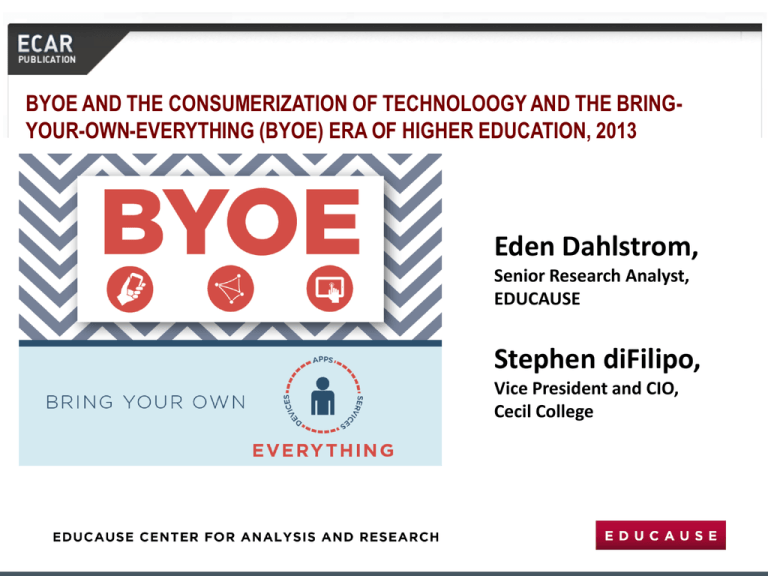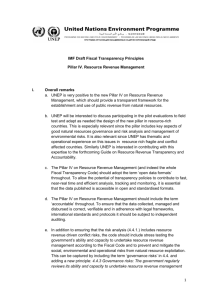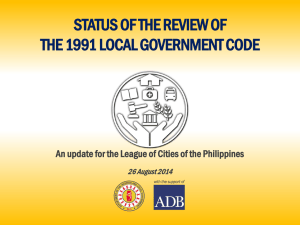Security Practices
advertisement

BYOE AND THE CONSUMERIZATION OF TECHNOLOOGY AND THE BRINGYOUR-OWN-EVERYTHING (BYOE) ERA OF HIGHER EDUCATION, 2013 Eden Dahlstrom, Senior Research Analyst, EDUCAUSE Stephen diFilipo, Vice President and CIO, Cecil College Slide Deck Overview Introduction and Methodology Findings Planning and Governance Security Practices Fiscal Considerations Technology Infrastructure Support Strategies Teaching and Learning Recommendations Introduction and Methodology Introduction: A Framework for the Most Important BYOE IT Issues in HE Introduction: Device Proliferation Is Manic Device proliferation is manic, and unmanaged growth could result in a “tragedy of the commons” situation, where too many devices find their way to campus networks too fast and institutions find more opportunities lost than taken. Introduction: IT Leaders Are Bracing for Personal Mobile Computing Environment Expansion Introduction: Students Go Mobile Smartphone ownership among undergraduate students increased from 55% in 2011 to 62% in 2012… …and the trend for more, different, and better devices is predicted to continue to increase. Introduction: Institutional Motivation for Permissive BYOE IT leaders want happy and productive faculty and staff. Introduction: Extending Enterprise Systems for Mobile Access Most institutions have already–or are planning to– extend enterprise systems to be compatible and friendly with mobile devices. Methodology IT Leader Interviews Focus Groups ECAR Survey Findings Findings: An Overview 1. Planning Doesn’t Necessarily Precede Action for BYOE 2. A Solid Security Presence and Plan Can Adjust to Most BYOE Security Challenges 3. Cost Savings from BYO Can Be Elusive 4. Think of IT Infrastructure as “Middleware” 5. Support Strategies Will Need to Adapt to BYOE Environments 6. Implications for Teaching and Learning Excite IT Professionals the Most about BYO Planning and Governance Planning and Governance: Formal Planning Strategies for BYOE Planning doesn’t have to precede action when it comes to BYOE—doing before planning is actually the norm—yet policies are in place where they matter most, such as for security or enduser behaviors. Planning and Governance: Policy Customs for Security Issues Formal policies for BYOE are scarce, yet they are common where they matter most, like for security issues. Planning and Governance: Policy Customs for Employee Behaviors Acceptable use and employee privacy expectation policies are the norm. Security Practices Security Practices: BYOE Security Issues Priorities A solid security presence and plan can adjust to most BYOE security challenges. Security Practices: BYOE Security Issues Priorities Managing risk and raising user awareness are two areas in which security practices are a wise investment. Security Practices: Focus on Securing Data Rather than Devices Data are the paramount institutional asset and are therefore the most important consideration when discussing BYOE security issues. Security Practices: Mandated BYO Security Training Is Common for Knowledge Workers Educating users about sound security practices will raise awareness of security risks. Fiscal Considerations Fiscal Considerations: Reimbursement Practices BYO reimbursements are NOT the norm in higher education. Fiscal Considerations: No Plans to Reduce Provisioned Devices for Students Some institutions are converting former computer labs into general collaboration spaces with power, Wi-Fi, printing stations, and free-moving future for ad hoc get-togethers. Fiscal Considerations: Financial Impact on IT Budgets BYOE can cost more than it saves. Fiscal Considerations: Reinvest in Infrastructure The cost to update/upgrade IT infrastructure can outweigh the cost savings from providing fewer institutionally provisioned devices and other technologies. Retiring or downsizing underused technologies and applying the savings to upgrade infrastructure is a wise investment. Technology Infrastructure Technology Infrastructure: BYOE “Middleware” Think of IT infrastructure as BYOE “middleware”—the commodities that bridge users, their devices, and their consumer-level applications to the institution’s data, services, systems, and enterprise-level applications. IT middleware should be robust yet nimble. Technology Infrastructure: Ubiquitous and Frictionless Access Including campus penetration of cellular coverage from main providers Including network Wi-Fi capabilities and open public WiFi versus restricted network access Including bandwidth and WiFi density ratios (i.e., number of devices per user) Including access capabilities through device, applications, browsers, virtualized desktops, identify management tools, and cloud services Technology Infrastructure: Current IT Practices that Relate to BYOE Technology Infrastructure: Upgrades Needed in Next Two Years Though present accommodation of BYOE is adequate, most respondents expect infrastructure upgrades within two years for Wi-Fi and networks, in particular. Support Strategies Support Strategies: Full and BestEffort Support are Common for Employees Current help desk support efforts for employees are extensive. Support strategies will need to adapt to BYOE environments. Support Strategies: Best Effort Support is Common For Students “Having the manpower to provide the support [is a challenge]. We will work on their devices if we have time.” – ECAR BYOE Survey Respondent Support Strategies: Increased Support Demand Estimates in Two Years 74% of institutions predict costs to increase for providing IT services to support user-provisioned technology. Support Strategies: Rating of BYOE Support Priorities as High or Essential Improving enduser experiences and providing more support are among the top priorities of IT leaders. Support Strategies: The New Support Paradigm as “Technology Consultant” 1. Routing help seekers to self-service portals and tutorials 2. Providing links to vendor resources or direct customer support 3. Crowdsourcing solutions through blogs, wikis, and Google searches 4. Using what Jarod Green from Gartner calls “Hey, Joe!” support–asking about until you find something that works rather than opening a support ticket Teaching and Learning Teaching and Learning: Priority for Facilitating Anytime, Anywhere Access + Student Guidelines Utilizing mobile technologies for T&L is a priority, but providing students guidance for how to do so is still rare. Teaching and Learning: Priority for Supporting Innovative Teaching Opportunities + Faculty Guidelines Balancing academic freedom, professional development, and expectations for end-user experiences is important. Teaching and Learning: Authority for Allowing/Disallowing Mobile Devices in F2F Courses There is a general sense that institutions are accommodating BYOE practices to the best of their abilities Recommendations Recommendations: Planning, Governance, and Leadership Have strong leadership and strong followthrough that address technology expectations at the top levels and are supported throughout the institution. Establish a mobile vision that considers human behavioral traits as a significant variable. Focus on having policies for issues that are within the purview of IT, such as securing data, and only have policies that can and will be enforced. Recommendations: Security Practices Balance rigorous security standards (managed risks) with user (in)conveniences. Accept that the proliferation of userprovisioned technologies does little to change the basic best practices around security—a solid security presence and plan on campus can adjust to most BYOE challenges. Recommendations: Security Practices Manage risk through securing data (access) rather than devices (assets). Collaborate with other units, such as human resources, to establish user-awareness training and education programs that focus on the understanding of risks of data exposure, how users can avoid security breaches, and how users can separate work and personal usage. Recommendations: Fiscal Considerations Don’t count on cost savings, but when they arise, invest in infrastructure. Reconsider reimbursement plans for BYO and retain these services only if there is the right combination of political and financial investment for your institution. Recommendations: Support Strategies Have clear and accessible support servicelevel options. Champion the paradigm shift so that BYOE means more DIY support. Strive to improve end-user experiences through empowering solutions such as “Hey, Joe” support crowdsourcing. Recommendations: Teaching and Learning Be mobile ready, willing, and able with a mobile-friendly environment that meets student, faculty, and staff expectations. Collaborate with other units to formalize systems for guiding students and faculty in incorporating mobile, networkable devices into the curriculum and pedagogy. If an IT organization currently provides effective and innovative services for university-owned technologies, it is likely well positioned to adapt to a bring-your-own culture. Contact the 2013 BYOE Research Team: Eden Dahlstrom Stephen diFilipo ecarstudy@educause.edu











